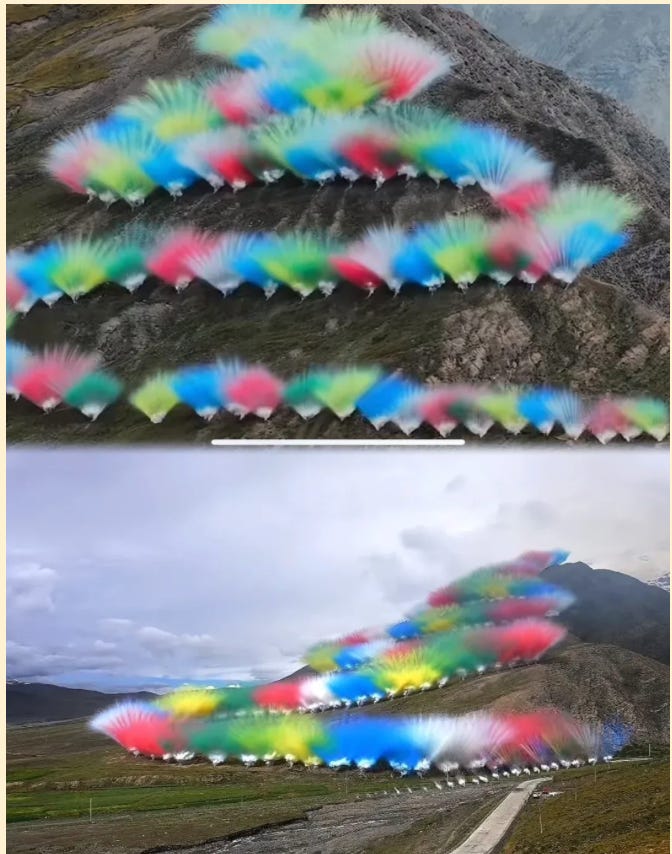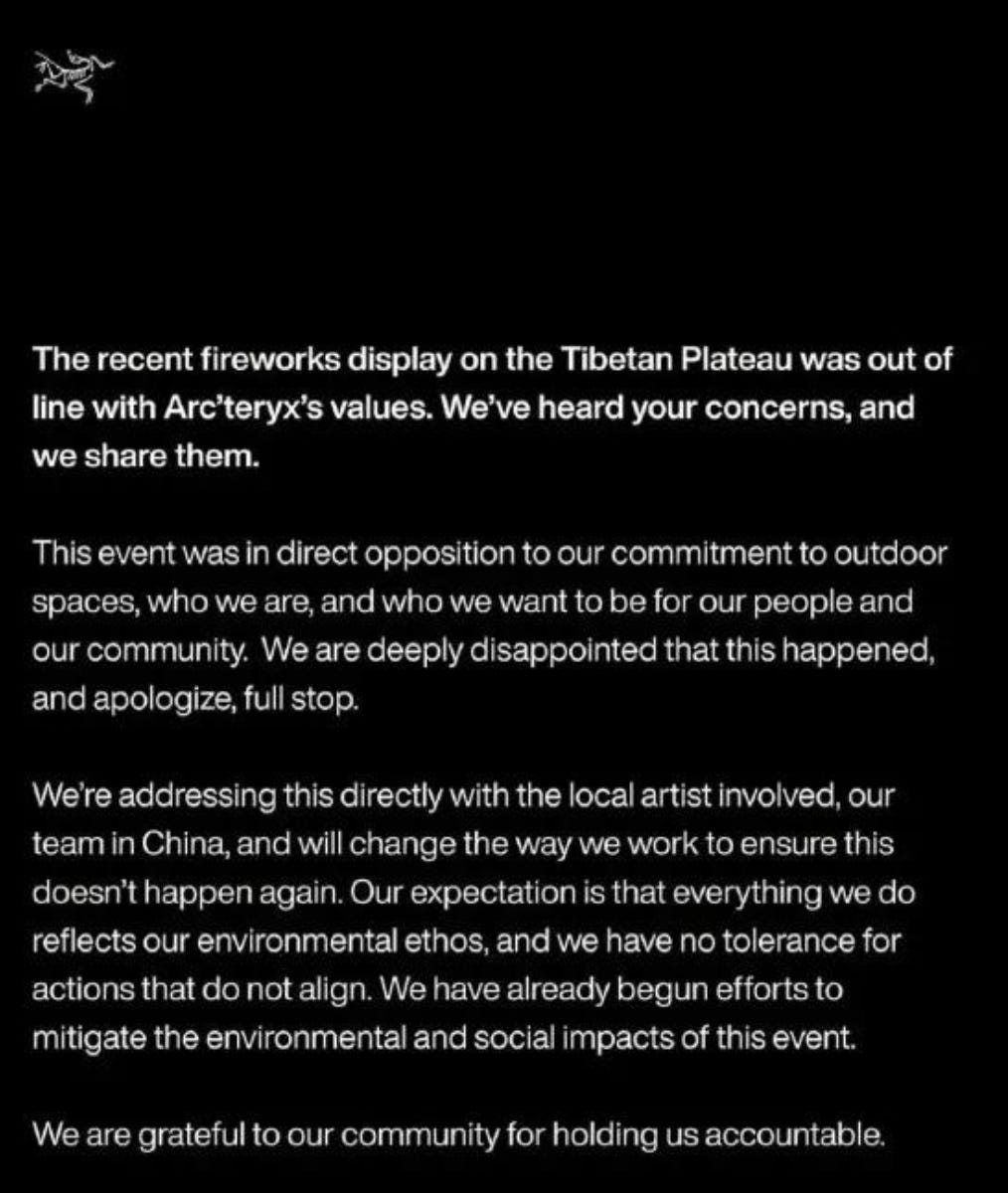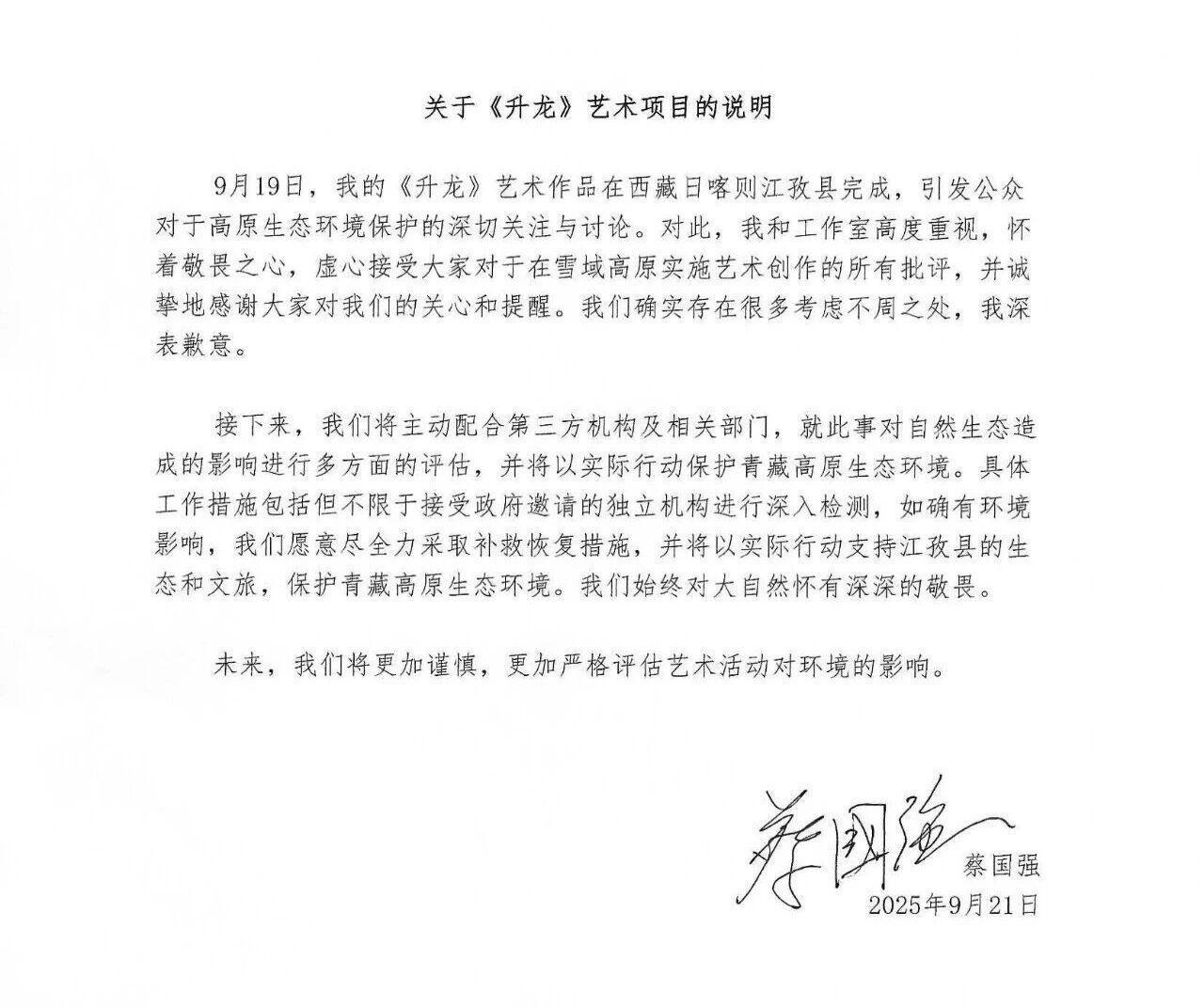Arc’teryx × Cai Guo-Qiang: One Crisis, Two PR Strategies
Yet another example of dual-narrative gone wrong
Much has been written about the Arc’teryx × Cai Guo-Qiang controversy. Zichen, Baiguan, and Yaling have strong analysis of the drama that’s unfolded over the weekend.
Instead of the what and how, I’m focusing on two things:
why Chinese netizens are furious (hubris, status signaling, a conquer-nature posture) and
how Arc’teryx’s global vs. China messaging split made the crisis worse, compounded by Cai’s lack of an English statement on his own channels.
Quick recap
The fireworks display, “Ascending Dragon,” was staged Friday by Arc’teryx and Cai Guo-Qiang at roughly 18,000 feet in the Himalayas—an extremely fragile alpine ecosystem in southwest Tibet (NBC News). After footage of the activation spread, backlash in China centered on sacred land and environmental risk. Local officials first said the materials were eco-friendly and no environmental impact assessment (EIA) was needed, then quickly announced a task force to investigate.
On September 21, both the brand and the artist apologized. Public expectations hardened around verifiable process, transparency, and honest disclosure of long-term impact.
Why are Chinese netizens so angry?
Ecology and sacred-land norms reduced to commercialization. High-altitude reserves are sensitive both environmentally and culturally. A gunpowder spectacle presented as a “tribute to nature” reads as using nature, not respecting it. In many such zones, access is tightly restricted; even holiday fireworks are often banned. This isn’t about everyone suddenly becoming environmentalists; it reflects a shift: consumers are no longer buying thinly veiled eco-marketing to sell more product.
Luxury posture vs. stewardship. Arc’teryx is positioned as a luxury brand in China on price, but its brand DNA is hardcore outdoor credibility. Founded in 1989, and now under Amer Sports (with Anta acquiring and taking Amer IPO last year. Anta is now the largest shareholder).
In China, Arc’teryx evolved from technical performance to status symbol. It still makes technical outdoor gear, but it has expanded beyond its core base to status-seeking consumers. As one widely shared online joke puts it, “the three treasures of middle-aged men are Moutai, fishing, and Arc’teryx.” Marketing spectacle without robust safeguards alienates the purists who built the brand’s credibility; courting a broader audience who buy for the brand prestige risks diluting the core brand value.
Tone and hubris. Many read the activation as a man-versus-nature, conquer-nature message—self-importance dressed up as tribute to nature. A big brand budget doesn’t make an activation relevant; here, it backfired. A younger audience increasingly rejects staged “representation,” whether it comes from corporate power or artistic authority. Arc’Teryx X Cai Guo-Qiang is getting all the bad press and backlash because they fundamentally misreads the current mood of “emotional capitalism,” which rewards connection and substance over grand gestures.
Fragmented comms: dual narrative at the core
Here is how the affected parties all responded:
Arc’teryx
The global response on Instagram (“A message from Arc’teryx”) effectively frames this as a project executed by “a China team and a local artist.” The signal: a rogue act over there, not us over here. That framing lands badly in China. It echoes a familiar trope—enjoy the China business, outsource the blame—and suggests the brand is defying or distancing itself from its Chinese parent owner. The ripple effect was swift. The drama remained on Weibo’s top search throughout the weekend.
Overseas (e.g., Instagram): just a note casting the incident as an isolated deviation from values—“we spoke to the artist and our China team; we’ll change how we work to avoid it from happening again.” That is distancing.
Domestically (Weibo, Red Note, Wechat official account): framed as an “apology,” much longer explanation promising process remedies—regulator-guided reviews, third-party assessments, and remediation based on findings. That is make-good homework.
Across China and the United States, the strategy reads as a double standard, and consumers and reporters take notice. U.S. and Chinese coverage flagged the communications gap, which in turn amplified anger inside China.
Cai Guo-Qiang
Cai apologized on his studio’s WeChat and Weibo, but not on his personal Instagram in English. His international footprint is significant—for instance, just this month an anonymous donor gave his 1991 work “Bigfoot’s Footprints: Project for Extraterrestrials No. 6” to the Metropolitan Museum of Art.
Yet apologizing only inside China intensified backlash on international platforms. His Instagram filled with protests and comments citing from China’s Wildlife Protection Law and the Regulations on Nature Reserves. On Chinese platforms, the questions echoed: Was there an assessment? By whom? When will results be public?
Chinese reporting indicates that staff at Cai’s Beijing studio said other departments executed the event; they reiterated that materials were “environmentally friendly,” could not speak to flora-fauna impact, referred inquiries to the New York studio, and ended the call.
Cai’s value to Arc’teryx is his blue-chip credibility: recent collaborations with Saint Laurent (Tokyo exhibition and daytime fireworks) and Lancôme; long-term support from the Asian Cultural Council, Fondation Cartier, the Getty Foundation/PST ART, the U.S. National Endowment for the Arts, the Museo del Prado, and P3 Tokyo. With that pedigree, Arc’teryx helped him “realize a dream” on a high-risk project. The same prestige that once helped win core enthusiasts can flip quickly when the narrative breaks.
Amer / Anta
Anta’s social accounts were flooded with negative comments; its official Weibo restricted follows and comments, and multiple Douyin videos were hidden. As of publication, there was no public statement from Anta. Amer Sports has not issued any media statements.
According to Chinese reporting, Anta told reporters to refer to Arc’teryx’s releases. Amer Sports’ share price fell more than 5%. Arc’teryx is Amer’s flagship and the engine of technical-apparel growth; China provides both the highest premium and incremental growth. Anta is the largest shareholder and, post-listing, still holds about 43%.
Arc’teryx’s brand health and China performance flow directly into group profits—turning a brand–artist PR mess into a bigger governance question: can Anta operate overseas high-end brands well and unlock long-term value?
In February 2024 when Amer listed on the NYSE (Yaling and I wrote about it last year)
touting “leading ESG performance,” which attracted sustainability-focused funds. The stock wobbled afterward, and the group leaned into high-profile environmental marketing—Arc’teryx ReBIRD™, Salomon’s “zero-waste factory,” and similar campaigns clustered around the listing window. The Tibet fireworks fit that pattern: marketing-led environmentalism—a spectacle to juice exposure while underestimating ecological risk. An expensive mistake.
Global communications: the baseline and the fix
The takeaway is straightforward. First, consistency is the starting point for global communications: one brand, one incident, one narrative. Local execution can adapt; the storyline cannot. Second, cultural fluency is non-negotiable. In sensitive natural or cultural settings, aesthetics give way to process and evidence that can withstand outside scrutiny. Third, credibility requires compliance from day one—and a promise to publish. Build the environmental assessment, material-residue testing, wildlife-disturbance thresholds, monitoring cadence, and disclosure channels into the brief; name the third party; set a timetable and milestones; and keep reporting while protecting legitimately sensitive information. That’s how you create durable public oversight—and the fastest path to rebuild trust.
The same bar applies to the artist. If the work and its impact cross borders, the explanation and accountability should, too. Even a concise English post laying out the facts and timeline would meet the baseline expectations of a global audience.






